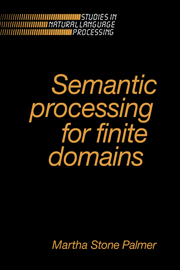
-
Select format
-
- Publisher:
- Cambridge University Press
- Publication date:
- 24 November 2009
- 28 September 1990
- ISBN:
- 9780511554414
- 9780521362269
- 9780521024037
- Dimensions:
- (228 x 152 mm)
- Weight & Pages:
- 0.412kg, 212 Pages
- Dimensions:
- (228 x 152 mm)
- Weight & Pages:
- 0.323kg, 212 Pages
You may already have access via personal or institutional login
Book description
A primary problem in the area of natural language processing has been that of semantic analysis. This book aims to look at the semantics of natural languages in context. It presents an approach to the computational processing of English text that combines current theories of knowledge representation and reasoning in Artificial Intelligence with the latest linguistic views of lexical semantics. This results in distinct advantages for relating the semantic analysis of a sentence to its context. A key feature is the clear separation of the lexical entries that represent the domain-specific linguistic information from the semantic interpreter that performs the analysis. The criteria for defining the lexical entries are firmly grounded in current linguistic theories, facilitating integration with existing parsers. This approach has been implemented and tested in Prolog on a domain for physics word problems and full details of the algorithms and code are presented. Semantic Processing for Finite Domains will appeal to postgraduates and researchers in computational linguistics, and to industrial groups specializing in natural language processing.
Contents
Metrics
Altmetric attention score
Full text views
Full text views help Loading metrics...
Loading metrics...
* Views captured on Cambridge Core between #date#. This data will be updated every 24 hours.
Usage data cannot currently be displayed.
Accessibility standard: Unknown
Why this information is here
This section outlines the accessibility features of this content - including support for screen readers, full keyboard navigation and high-contrast display options. This may not be relevant for you.
Accessibility Information
Accessibility compliance for the PDF of this book is currently unknown and may be updated in the future.


